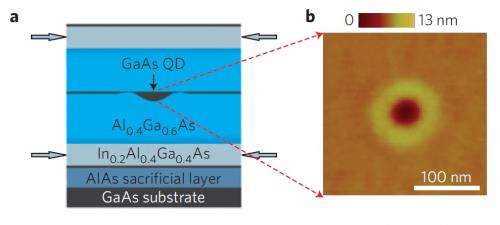December 6, 2013 feature
Quantum dots with confined light holes could have applications in quantum technologies

(Phys.org) —Semiconductor quantum dots are being widely studied for their potential use in future quantum technologies. One of the reasons for their appeal is that they can confine quantum bits such as excitons and spins inside of them. In a new study, researchers have created a quantum dot that contains an exciton in the form of an electron bound to a light hole. The use of a light (as opposed to heavy) hole could enable the quantum dots to have specific advantages for quantum information technologies.
The team of researchers, Y. H. Huo, et al., from institutes in Germany, The Netherlands, and Austria, have published their paper on light-hole excitons confined in quantum dots in a recent issue of Nature Physics.
As the researchers explain, heavy holes and light holes behave differently because they are located on different valence energy bands in a semiconducting material. To create these holes, the researchers excited the electrons in these energy bands using light. When an excited electron moves to the conduction band, it leaves an empty state in one of the valence bands. This missing electron behaves as a particle (a hole) with positive charge and a mass that depends on which valence band it is in. A hole in the so-called "light-hole band" behaves like a particle with a mass that is several times lower than a hole in the "heavy-hole" band.
So far, all experimental studies in which holes are confined in quantum dots have used heavy holes because they are easier to confine from an energetic standpoint. However, some theoretical analyses have suggested that using light holes instead of heavy holes would be beneficial for quantum information technologies. Potential benefits include the ability to achieve faster control and more direct measurements of the spin states.
In order to experimentally investigate these potential benefits, the researchers for the first time created quantum dots with light-hole ground states. Instead of completely redesigning the quantum dot geometry, they demonstrated that strain engineering could be used to create these dots.
The strain method involves creating initially unstrained quantum dots in pre-stressed membranes, and then inducing tensile strain on the dots by releasing the membranes from the substrate. The tensile strain shifts the quantum dots' character from dominantly heavy-hole to dominantly light-hole. When the membranes are placed on a piezoelectric substrate, the tensile strain can be further increased or decreased, enabling the emission energy and the hole character to be tuned. As the researchers showed both experimentally and theoretically, quantum dots that contain dominantly light-hole ground states have a clearly distinct signature compared to those with dominantly heavy-hole ground states.
Using strain engineering, the researchers demonstrated that the ground hole state in the quantum dot can have more than 95% light-hole character for tensile strains of 0.4%. The quantum dots also have a high optical quality that is comparable to that of state-of-the-art quantum dots. Combined with the fact that the membranes are compatible with electric control, these features show that quantum dots with confined light holes can soon be explored as new building blocks for quantum technologies.
"Light-hole excitons may enable direct conversion of the polarization of a photon (flying qubit) into the spin state of an electron confined in a quantum dot (stationary qubit)," coauthor Armando Rastelli, Professor of Semiconductor Physics at Johannes Kepler University Linz in Linz, Austria, told Phys.org. Rastelli is also affiliated with IFW Dresden in Germany. "In addition, light-hole spins (another form of stationary qubit) may be directly manipulated via microwaves and at higher rates compared to heavy-hole spins. Dedicated experiments will be needed to assess which of these potentials can be realized in practice."
In the future, the researchers plan to investigate how heavy holes become light holes, as well as other open questions.
"Next we plan to look in detail at the transition from a heavy-hole to a light-hole ground state," Rastelli said. "With the technological approach used in the paper, this was not possible. We are now designing a piezoelectric actuator which may allow us to follow smoothly the emission changes as heavy- and light-hole states cross each other. In addition, we are in touch with colleagues planning to investigate the properties of light-hole spins."
More information: Y. H. Huo, et al. "A light-hole exciton in a quantum dot." Nature Physics. DOI: 10.1038/NPHYS2799
Journal information: Nature Physics
© 2013 Phys.org. All rights reserved.

















